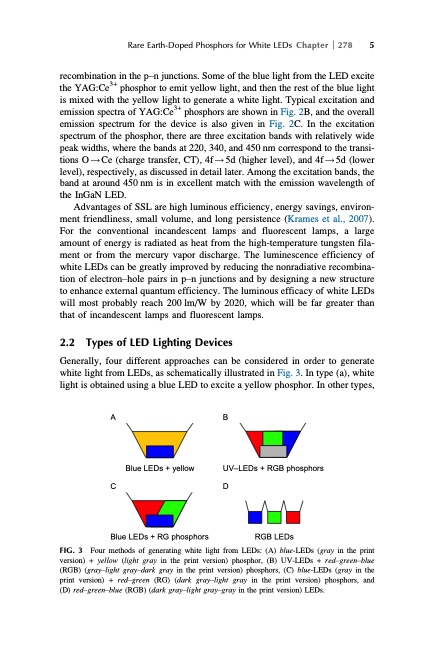
PDF Publication Title:
Text from PDF Page: 041
Rare Earth-Doped Phosphors for White LEDs Chapter 278 5 recombination in the p–n junctions. Some of the blue light from the LED excite the YAG:Ce3+ phosphor to emit yellow light, and then the rest of the blue light is mixed with the yellow light to generate a white light. Typical excitation and emission spectra of YAG:Ce3+ phosphors are shown in Fig. 2B, and the overall emission spectrum for the device is also given in Fig. 2C. In the excitation spectrum of the phosphor, there are three excitation bands with relatively wide peak widths, where the bands at 220, 340, and 450 nm correspond to the transi- tions O!Ce (charge transfer, CT), 4f!5d (higher level), and 4f!5d (lower level), respectively, as discussed in detail later. Among the excitation bands, the band at around 450 nm is in excellent match with the emission wavelength of the InGaN LED. Advantages of SSL are high luminous efficiency, energy savings, environ- ment friendliness, small volume, and long persistence (Krames et al., 2007). For the conventional incandescent lamps and fluorescent lamps, a large amount of energy is radiated as heat from the high-temperature tungsten fila- ment or from the mercury vapor discharge. The luminescence efficiency of white LEDs can be greatly improved by reducing the nonradiative recombina- tion of electron–hole pairs in p–n junctions and by designing a new structure to enhance external quantum efficiency. The luminous efficacy of white LEDs will most probably reach 200 lm/W by 2020, which will be far greater than that of incandescent lamps and fluorescent lamps. 2.2 Types of LED Lighting Devices Generally, four different approaches can be considered in order to generate white light from LEDs, as schematically illustrated in Fig. 3. In type (a), white light is obtained using a blue LED to excite a yellow phosphor. In other types, AB Blue LEDs + yellow UV–LEDs + RGB phosphors CD Blue LEDs + RG phosphors RGB LEDs FIG. 3 Four methods of generating white light from LEDs: (A) blue-LEDs (gray in the print version) + yellow (light gray in the print version) phosphor, (B) UV-LEDs + red–green–blue (RGB) (gray–light gray–dark gray in the print version) phosphors, (C) blue-LEDs (gray in the print version) + red–green (RG) (dark gray–light gray in the print version) phosphors, and (D) red–green–blue (RGB) (dark gray–light gray–gray in the print version) LEDs.PDF Image | HANDBOOK ON THE PHYSICS AND CHEMISTRY OF RARE EARTHS

PDF Search Title:
HANDBOOK ON THE PHYSICS AND CHEMISTRY OF RARE EARTHSOriginal File Name Searched:
Chemistry-Rare-Earths-49.pdfDIY PDF Search: Google It | Yahoo | Bing
Sulfur Deposition on Carbon Nanofibers using Supercritical CO2 Sulfur Deposition on Carbon Nanofibers using Supercritical CO2. Gamma sulfur also known as mother of pearl sulfur and nacreous sulfur... More Info
CO2 Organic Rankine Cycle Experimenter Platform The supercritical CO2 phase change system is both a heat pump and organic rankine cycle which can be used for those purposes and as a supercritical extractor for advanced subcritical and supercritical extraction technology. Uses include producing nanoparticles, precious metal CO2 extraction, lithium battery recycling, and other applications... More Info
| CONTACT TEL: 608-238-6001 Email: greg@infinityturbine.com | RSS | AMP |